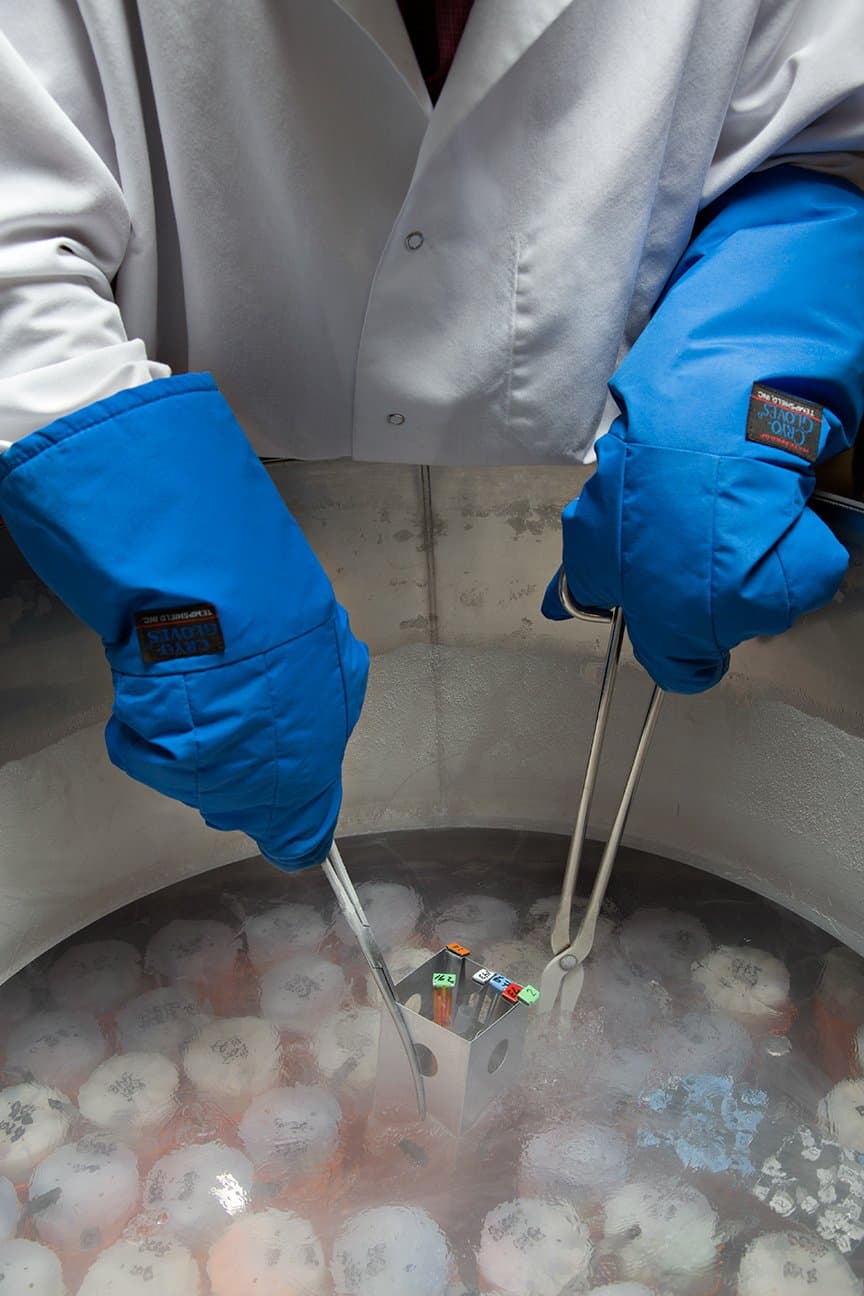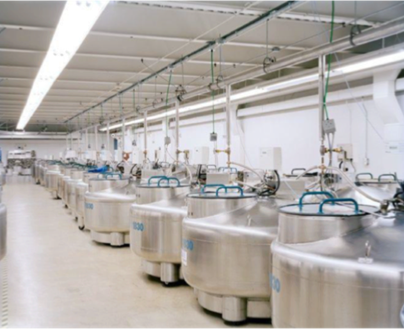Safeguarding the Valuable Genetic Stock Collections of Public Repositories

The National Institutes of Health (NIH) Office of Research Infrastructure Programs (ORIP) supports many resource centers that develop animal models for research. These resources—which include models involving fish, mice, rats, and nematodes, among others—represent some of the largest repositories of living and cryopreserved genetic stocks available to the research community.
These resource centers store germplasm samples from their models—biological materials, including sperm and eggs, that preserve the haploid genetic material of the models. The samples are stored through cryopreservation, which involves cooling them to very low temperatures (-196°C) using liquid nitrogen (Figure 1). The cryopreserved samples ensure that genetic material for each model strain created by the resource center can be accessed again in the future, if necessary. However, accidents, natural disasters, and other unlikely incidents have the potential to damage ORIP resource centers and the germplasm samples they store, and those samples stored in only one location could be permanently lost.
To prepare for natural disasters and ensure that valuable samples are not permanently lost, ORIP has partnered with the U.S. Department of Agriculture (USDA) to store backup collections of these samples at the National Laboratory for Genetic Resources Preservation (NLGRP) in Fort Collins, Colorado. The NLGRP supports the food security aspect of USDA’s mission, and most of the samples stored at the NLGRP preserve the genetics of food sources, explained Dr. Harvey Blackburn, coordinator of the National Animal Germplasm Program (NAGP) at the NLGRP.
The NLGRP is the world’s largest agricultural gene bank, and the NAGP stores more than 1 million samples from more than 55,000 animals—mainly livestock species and aquatic species used for food consumption. The storage vault at the NLGRP secures large liquid nitrogen storage tanks used for the cryopreserved samples with numerous automated systems and can be self-sufficient for 3–4 weeks, if necessary. The vault is designed to resist earthquakes and floods and operates with 24-hour security and restricted staff access. The NLGRP has agreed to store samples of more than 11,000 zebrafish lines and more than 16,000 strains of Caenorhabditis elegans, with storage of additional types of samples from other resources planned.
Adding new ORIP resources to the NLGRP collection is simple, requiring no additional setup or paperwork—researchers simply include any new samples with the updates regularly sent to the NLGRP. Dr. Blackburn explained that future advancements in preservation technologies are unlikely to require major changes at the NLGRP, so the samples can be stored for many years securely and without disruption (Figure 2). Any advances in cryopreservation technology likely would be incorporated at the ORIP resource centers, rather than the NLGRP, and would already be part of the regular process of preserving samples before those samples were sent to the NLGRP.
Because of the large number of samples stored at NAGP, preserving ORIP materials is a simple addition to normal day-to-day processes at the NLGRP. ORIP’s resource centers regularly distribute live animals to researchers around the country for use in their basic and biomedical research, but the resource centers send samples of new acquisitions or strains created to the NAGP for backup storage only about once per year. ORIP samples then become one small component of the large collection of materials the NLGRP preserves. Dr. Blackburn emphasized that if samples at a resource center were lost, accessing the backups stored at the NLGRP would be simple, requiring only a phone call or an online request.

ORIP initiated the partnership with the NLGRP about 6 years ago to take advantage of the National Laboratory’s infrastructure and cryopreservation capabilities. The NLGRP maintains relationships with a diverse set of stakeholders who entrust the backup storage of their genetic samples to the NLGRP. Dr. Blackburn noted that he works with representatives from livestock and food animal industries, as well as the research communities associated with those industries. He also works with agricultural marketing services and international institutions to store samples of plants and other living organisms. Additionally, the NLGRP stores coral samples for the Smithsonian Institution.
Industry trends, such as changing dietary preferences, are important factors in how Dr. Blackburn and his team develop and expand the collection. Because samples from the collection can be kept in storage for decades, the NLGRP’s large and diverse collection includes food sources that may have been more common in previous years. “You never know when something may be useful that may not exist outside the collection,” Dr. Blackburn commented. He noted that agricultural researchers have requested samples from the collection that are 40 or 50 years old to address a particular question about the history of food sources and their adaptation to environmental challenges. Samples stored for many years—whether related to agriculture research or biomedical research—have the potential to answer unknown future questions.
In addition to mirroring the evolution of industry trends, the NLGRP collection can weather the sorts of extreme events that prompted ORIP to establish the partnership. For example, one of the ORIP resource centers experienced a fire several years ago. Although no biological materials were lost, ORIP’s partnership with the NLGRP provided an extra layer of security and peace of mind for safeguarding genetic stocks. In the agricultural sphere, the threat of emerging diseases prompts organizations to send samples to the NLGRP for safekeeping. As an example of how the storage of existing stocks is increasingly important in times of uncertainty, Dr. Blackburn noted that the agricultural swine community is worried about African swine fever, a virus lethal to swine and for which no vaccine yet exists. By preserving the past and present genetic stocks from ORIP-supported resources, the NLGRP is safeguarding the future of animal models used for research.



